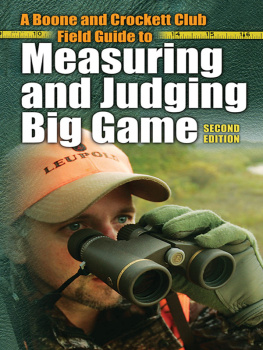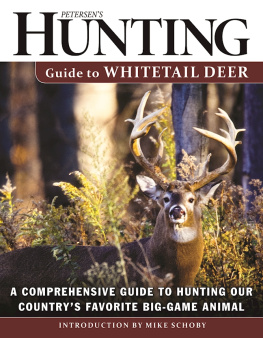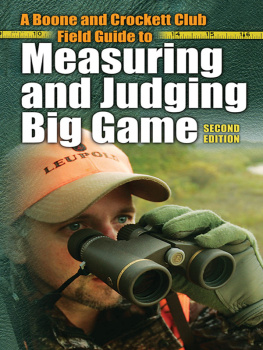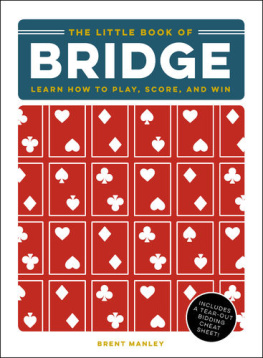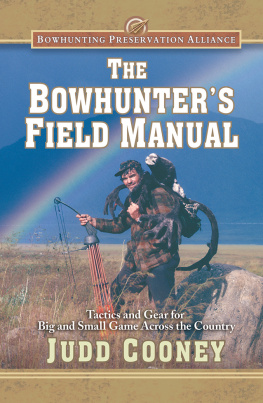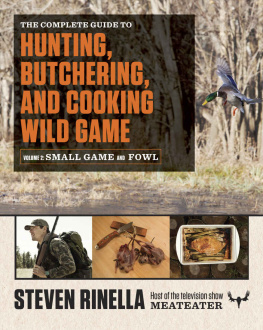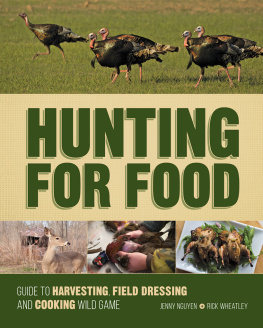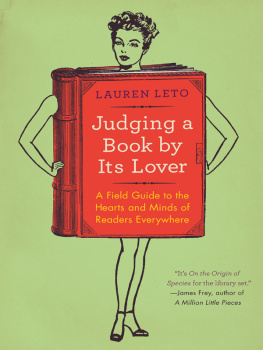
A BOONE AND CROCKETT CLUB FIELD GUIDE TO MEASURING AND JUDGING BIG GAME
Second Edition 2010
eBook Edition 2011
Copyright 2010 by the Boone and Crockett Club.
All rights reserved, including the right to reproduce this book or portions thereof in any form or by any means, electronic or mechanical, including photocopying, recording, or by any information storage and retrieval system, without permission in writing from the Boone and Crockett Club.
Library of Congress Catalog Card Number: 2010903839
Paperback ISBN Number: 978-0-940864-66-5
eBook ISBN Number: 978-0-940864-78-8
Published May 2010
Published in the United States of America
by the
Boone and Crockett Club
250 Station Drive
Missoula, MT 59801
406/542-1888
406/542-0784 (fax)
www.booneandcrockettclub.com
A Boone and Crockett Club Field Guide to
Measuring and Judging Big Game
SECOND EDITION
By Jack Reneau, Eldon L. Buck Buckner, Philip L. Wright and William H. Nesbitt
Illustrated by DeWayne Williams and Larry Jensen
Sponsored by Leupold and Stevens

FOREWORD
Third Generation Once Removed
The Boone and Crockett Clubs trophy scoring system is relatively new, copyrighted in 1950 after 12 years of development. It was readily accepted in both the United States and Europe as the standard by which North American big game species is judged. A history of records keeping is included as a separate chapter in this guide for those interested.
Grancel Fitz of New York was a major developer of the B&C scoring system, as well as the first sportsmen to take trophy heads of all North American big game species. One of Grancels ambitions was to publish an inexpensive guide for the average sportsman that would explain the scoring system for the various big game species. In 1963, Grancels soft cover How to Measure and Score Big Game Trophies was published by Outdoor Life, with a foreword by both B&C Records Committee chairman Samuel Webb and Grancels friend and famous gun writer, Jack OConnor. Unfortunately, Grancel died as the book was being published.
I am very familiar with Grancels guide, as it was the only thing available on measuring in 1969 when I organized the first measuring seminars for Arizonas records program. Already out of print, I was finally able to acquire three dozen copies from Grancels widow, Betty. Boone and Crockett measurers began being trained in a similar fashion some six years later, which led to the next publication on measuring technique.
This guide, in its second edition, may be considered a third generation distant relative of Grancels little book, directly descended from Wm. Harold Nesbitt and Philip L. Wrights Measuring and Scoring North American Big Game Trophies published by the Boone and Crockett Club in 1985, and later updated and revised in 1997, 2000, and 2009. These editions, originally developed in response to the glaring need for a comprehensive instruction manual for training new official measurers, mentioned earlier, continue to be revised and published for that purpose.
As the interest in selective hunting and big game trophies continues to increase and new generations become involved, there is an increasing demand for more information on the subject. This publication is intended to answer questions about how to score big game trophies, with numerous illustrations, as well as to give helpful pointers on field judging trophy quality in the field on the hoof. It also provides answers to many common questions about distribution of species categories and trophy entry procedures. Too, I think most hunters will find the comparison photos of Worlds Record heads and those barely meeting minimum scores both interesting and helpful in evaluating what they see in the field.
Hunting is a special outdoor pursuit that has many different facets for each of us. Some of us take it much more seriously than others. However, we should all remember that it is meant primarily as outdoor recreation, although a recreation that involves the eternal natural cycle of life and death and thus should be engaged with only the utmost respect for the animals pursued. If the information on the following pages helps you achieve greater appreciation, satisfaction, or enjoyment from your all-too-few days afield, then its objective will have been met.
Eldon Buck Buckner
Chairman, Records of North American Big Game Committee
INTRODUCTION
The Hunt vs. the Catch
A peculiar virtue in wildlife ethics is that the hunter ordinarily has no gallery to applaud or disapprove of his conduct. Whatever his acts, they are dictated by his own conscience, rather than by a mob of onlookers. It is difficult to exaggerate the importance of this fact.
Aldo Leopold
Boone and Crockett Club member
When we first start hunting, usually in our youth, we are interested only in the catch . The hunt is the means to the end. As hunters mature, we educate ourselves about the quarry. What types of foods does it eat and at what times of the year? How does it respond to various weather situations or even the phases of the moon? We learn its actions during the rut. We learn how to try to predict the animal. As we go through this process we learn to love the animal as well. We want it to survive and proliferate. We want to improve the animals habitat to achieve this end. In essence, we become conservationists. Somewhere in this maturing process we start to make the hunt the most important part of the process, which leads to making the catch more challenging. In doing this, the hunt becomes more arduous, more challenging, and more enjoyable. Some will take up muzzleloaders, or the bow and arrow to add to this challenge and enjoyment. All of us inevitably start to look for a more mature animal. The first reason is that with maturity comes wisdom. Some might say the animal becomes more cunning but in reality it hones its survival instincts and becomes much harder to catch. The hunt gradually becomes dominant. This book is dedicated to those of us that are on this quest.

Dont mistake this book for a How to Get a Trophy book. At the Boone and Crockett Club, we recognize that the mature animal in the best habitat produces the greatest measurements. The production of these magnificent specimens is a celebration of the North American Model of Wildlife Conservation. This book will help you to be able to judge the animal when your hunt nears its finality. With the knowledge contained in this book you may chose to let more, less mature animals go. But I guarantee, when your arduous quest and skill puts you into the position to take that magnificent specimen, you will recognize it with the help of the knowledge in this book. You will learn to make well-informed decisions about the quality of the game animals while out in the field. You will learn the techniques for scoring the big game you harvest. This new edition updates the latest information from the Boone and Crockett Clubs Records Program. We have also endeavored to make this a sturdier book that you can take into the field.
Good luck in your hunt .
Howard P. Monsour, Jr.
Chairman, Publications Committee
Next page
